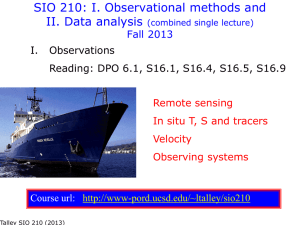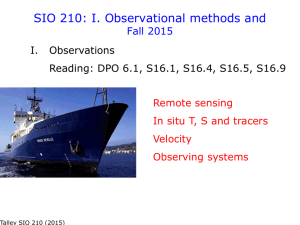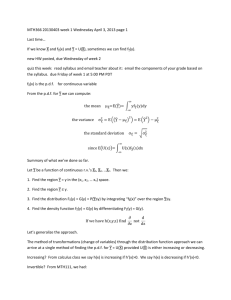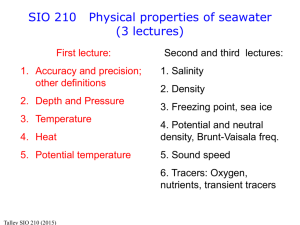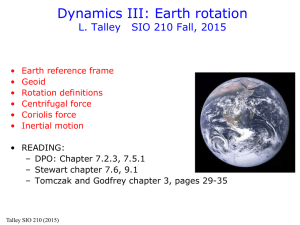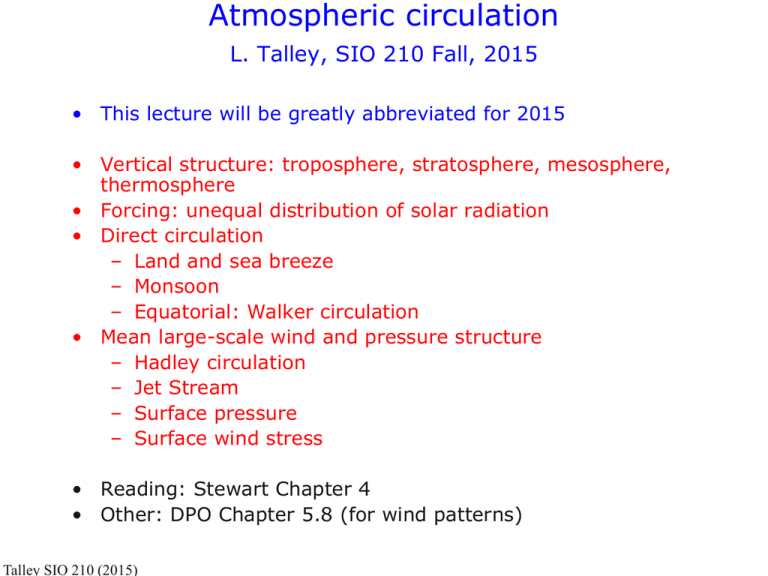
Atmospheric circulation
L. Talley, SIO 210 Fall, 2015
• This lecture will be greatly abbreviated for 2015
• Vertical structure: troposphere, stratosphere, mesosphere,
thermosphere
• Forcing: unequal distribution of solar radiation
• Direct circulation
– Land and sea breeze
– Monsoon
– Equatorial: Walker circulation
• Mean large-scale wind and pressure structure
– Hadley circulation
– Jet Stream
– Surface pressure
– Surface wind stress
• Reading: Stewart Chapter 4
• Other: DPO Chapter 5.8 (for wind patterns)
Talley SIO 210 (2015)
Talley SIO 210 (2015)
Cloud cover
associated with sea level pressure
(low pressure = rising air - moist;
high pressure = sinking air – dry)
Cloud fraction (monthly average for August, 2010) from MODIS on NASA’s Terra satellite. Gray scale
ranges from black (no clouds) to white (totally cloudy). Source: From NASA Earth Observatory (2010).
TALLEY
Talley SIO 210 (2015)
Copyright © 2011 Elsevier Inc. All rights reserved
DPO Figure 5.8
NASA wind products
Talley SIO 210 (2015)
Atmosphere
structure
From NASA
Science site
Talley SIO 210 (2015)
Kump, Kasting, Crane (2004) textbook
Atmospheric temperature structure
Troposphere: nearly uniform potential temperature so
temperature drop with height is nearly adiabatic
Stratosphere is warmest at top: due to absorption of the
sun’s UV radiation. (The ozone maximum is in the
middle of the stratosphere.)
Also see
http://earthguide.ucsd.edu/earthgu
ide/diagrams/atmosphere/index.ht
ml
Talley SIO 210 (2015)
Kump, Kasting, Crane (2004) textbook
Adiabatic lapse rate and potential
temperature
Air is compressible (much more so than water). Thus the effects of
compressibility on temperature are much the same as we’ve
already learned for the ocean.
Adiabatic lapse rate :
d = -(dT/dz)dry parcel = g/cp
where subscript d = dry, using the 1st law of thermodynamics to relate
temperature and pressure change, and then using hydrostatic balance.
In dry atmosphere, adiabatic lapse rate is 9.8 °/km
In moist atmosphere, adiabatic lapse rate is 6 to 7 °/km
Potential temperature: reference level is the ground, taken as
1000 mbar.
Talley SIO 210 (2015)
Winds
•Winds are forced mainly by heating from the earth’s
surface below.
•Air rises in warmer locations.
•(As it rises, if over the ocean, it tends to carry moisture
and cause precipitation.)
•Because it has much higher specific heat, water
temperature varies much more weakly with given surface
heat flux than does land (since dirt includes both water and
lower-specific-heat air).
•With diurnal or seasonal forcing of adjacent land and sea,
the sea temperature varies a little and the land temperature
varies a lot. This creates diurnal or seasonal reversals of
locations of rising air in the atmosphere (“seabreeze” and
“monsoon”)
•“Direct circulation”: wind (or current) blowing from high to
low pressure
Talley SIO 210 (2015)
Direct circulation
•“Direct circulation”: wind (or current) blowing
from high to low pressure. Rotation effects are
either negligible or relatively unimportant
•Examples presented here:
1. Diurnal winds (sea and land breeze, driven
by land-sea temperature contrast)
2. Monsoonal winds (seasonal, driven by landsea temperature contrast in the tropics
where rotation is a minor factor)
3. Walker circulation (permanent, equatorial
atmospheric circulation driven by zonal SST
contrast)
Talley SIO 210 (2015)
Wind response to differential heating:
Diurnal - Land and sea breeze
• Diurnal cycle of heating and cooling
• Land temperature extremes are much larger than ocean
temperature extremes through the daily cycle (because
the specific heat of water is so high compared with air
and dirt)
• Hot-cold contrast creates upward convection in the air
above the warm area (land in the day, ocean in the
night), and sinking over the cooler area
Talley SIO 210 (2015)
Wind response to differential heating:
Seasonal - Monsoons
• Same idea as diurnal sea breeze: ocean seasonal temperature range is
much smaller than land seasonal temperature range. Rising air over
warmer area and sinking over cooler, modified by Coriolis deflection
• “Direct circulation” driven by differences in heating and cooling
Northern hemisphere summer
Talley SIO 210 (2015)
Northern hemisphere winter
Kump, Kasting, Crane (2004) textbook
Annual range of surface temperature
(°F)
Kump, Kasting, Crane (2004) textbook
Talley SIO 210 (2015)
Can see that monsoon is not driven by the SST annual range in the Arabian Sea–
has to be the land annual range. Monsoon: SST remains relatively constant while
land temperature goes through large annual cycle.
Annual range of sea surface temperature (°C), based on monthly climatological
temperatures from the World Ocean Atlas (WOA05) (NODC, 2005a, 2009).
Talley SIO 210 (2015)
DPO Fig. 4.9
Monsoons (seasonal)
WARM
Jun-Aug (SW monsoon)
Talley SIO 210 (2015)
COLD
Dec-Feb (NE monsoon)
Equatorial winds: Direct atmospheric circulation
Walker circulation: (Coriolis not important as f ~ 0)
“Bjerknes feedback” between
the ocean and atmosphere.
Warm water causes air to rise,
creates wind, that sets up
currents, that causes SST
contrast.
Talley SIO 210 (2015)
Mean large-scale wind and pressure structure
Convection and subsidence, in response to global heating
and cooling
What we might expect from
global heating and cooling
What we actually have - 3
cells - due to rotation
1. Hadley 2. Ferrel 3. Polar
Talley SIO 210 (2015)
Meridional view of global winds
Sinking air
Rising air
Subsidence
ITCZ
Stewart Fig. 4.3
Talley SIO 210 (2015)
1. Hadley cell
ITCZ = Intertropical Convergence Zone
Actually not exactly on equator: seasonal variations in insolation, so
ITCZ sits at maximum heating location.
ITCZ is well developed north of equator
Subsidence at about 30 °N, S
Talley SIO 210 (2015)
(because of land distribution).
Kump, Kasting, Crane (2004) textbook
Intertropical Convergence Zone
Atlantic Ocean 9/04
Pacific Ocean
ITCZ spawns hurricanes
Talley SIO 210 (2015)
The three cells and the jet streams: Polar
and Subtropical Jets
Polar easterlies
Talley SIO 210 (2015)
Westerlies
Trades (easterlies)
Annual mean surface winds and surface pressure
LOW
LOW
WESTERLIES
HIGH
HIGH
LOW TRADE WINDS
HIGH
HIGH
WESTERLIES
LOW
Talley SIO 210 (2015)
HIGH
Wind stress
• Wind stress is what drives the ocean (waves, currents).
• Transfer of momentum from wind to ocean.
• Wind speed is measured above the sea surface. In
practice measurements are at different heights. For
consistency, adjust all measurements to a 10 meter
height.
• Actual stress on the ocean:
= cDu2
where u is the wind speed at 10 meters, is the air
density 1.3 kg/m3, and cD is the (dimensionless) drag
coefficient, which is determined empirically.
Units of wind stress: Newton/m2
(check this using density times velocity squared)
Talley SIO 210 (2015)
Wind stress and wind speed
Wind stress is the force per unit area exerted by the wind on
the ocean
Stress τ = ρc D u10 2
in units of N/m2 (or dynes/cm2)
Where u10 = wind speed at 10 m height
ρ is air density 1.3 kg/m3
c D is a “drag coefficient” (dimensionless)
At low wind speeds, c D ≈ 1.1 x 10-3
At higher wind speeds, c D ≈ (0.61 + 0.063 u) x 10-3
COARE 3.0 algorithm Fairall et al. (J. Climate 2003)
Stewart section 4.5
Talley SIO 210 (2015)
Wind stress continued
Typical value for drag coefficient:
low wind speed
cD= 1.1 x 10-3
as wind speed increases:
cD= (0.61 + 0.063u) x 10-3
Talley SIO 210 (2015)
Stewart Fig. 4.6
COARE 3.0 algorithm, drag coefficient
Talley SIO 210 (2015)
Kara et al. (J. Clim. 2007)
Surface wind stress (northern summer)
• Average wind speeds up to 10 m/sec (factor of 10 greater
than ocean current speeds)
• Note westerlies and trades
• Monsoonal winds in Indian Ocean
• Look for monsoons in other tropical locations
Talley SIO 210 (2015)
DPO Fig. 5.16a


